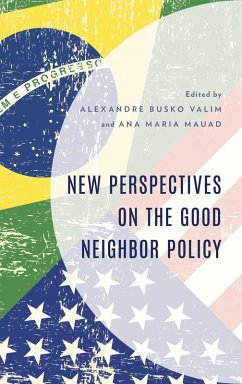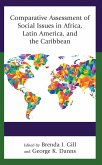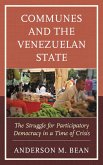New Perspectives on the Good Neighbor Policy (eBook, PDF)
Redaktion: Valim, Alexandre Busko; Mauad, Ana Maria
79,95 €
79,95 €
inkl. MwSt.
Sofort per Download lieferbar

40 °P sammeln
79,95 €
Als Download kaufen

79,95 €
inkl. MwSt.
Sofort per Download lieferbar

40 °P sammeln
Jetzt verschenken
Alle Infos zum eBook verschenken
79,95 €
inkl. MwSt.
Sofort per Download lieferbar
Alle Infos zum eBook verschenken

40 °P sammeln
New Perspectives on the Good Neighbor Policy (eBook, PDF)
Redaktion: Valim, Alexandre Busko; Mauad, Ana Maria
- Format: PDF
- Merkliste
- Auf die Merkliste
- Bewerten Bewerten
- Teilen
- Produkt teilen
- Produkterinnerung
- Produkterinnerung

Bitte loggen Sie sich zunächst in Ihr Kundenkonto ein oder registrieren Sie sich bei
bücher.de, um das eBook-Abo tolino select nutzen zu können.
Hier können Sie sich einloggen
Hier können Sie sich einloggen
Sie sind bereits eingeloggt. Klicken Sie auf 2. tolino select Abo, um fortzufahren.

Bitte loggen Sie sich zunächst in Ihr Kundenkonto ein oder registrieren Sie sich bei bücher.de, um das eBook-Abo tolino select nutzen zu können.
The Second World War was a watershed moment in US-South American relations. Yet the Good Neighbor Policy-the driving force behind many of the changes during this time-remains underanalyzed, especially from a South American perspective. Examining topics ranging from literary fashions and trends in the press to science, militarism, and gender categories, New Perspectives on the Good Neighbor Policy sheds light on this crucial period in which the US defined geopolitical relations with South America and solidified its hemispheric hegemony. Additionally, the contributors evaluate the legacy of the…mehr
- Geräte: PC
- mit Kopierschutz
- eBook Hilfe
- Größe: 7.89MB
Andere Kunden interessierten sich auch für
![New Perspectives on the Good Neighbor Policy (eBook, ePUB) New Perspectives on the Good Neighbor Policy (eBook, ePUB)]() New Perspectives on the Good Neighbor Policy (eBook, ePUB)79,95 €
New Perspectives on the Good Neighbor Policy (eBook, ePUB)79,95 €![African Diaspora in the Cultures of Latin America, the Caribbean, and the United States (eBook, PDF) African Diaspora in the Cultures of Latin America, the Caribbean, and the United States (eBook, PDF)]() African Diaspora in the Cultures of Latin America, the Caribbean, and the United States (eBook, PDF)33,95 €
African Diaspora in the Cultures of Latin America, the Caribbean, and the United States (eBook, PDF)33,95 €![Gang Strategies in the Northern Triangle (eBook, PDF) Gang Strategies in the Northern Triangle (eBook, PDF)]() Adam GolobGang Strategies in the Northern Triangle (eBook, PDF)62,95 €
Adam GolobGang Strategies in the Northern Triangle (eBook, PDF)62,95 €![Comparative Assessment of Social Issues in Africa, Latin America, and the Caribbean (eBook, PDF) Comparative Assessment of Social Issues in Africa, Latin America, and the Caribbean (eBook, PDF)]() Comparative Assessment of Social Issues in Africa, Latin America, and the Caribbean (eBook, PDF)79,95 €
Comparative Assessment of Social Issues in Africa, Latin America, and the Caribbean (eBook, PDF)79,95 €![Communes and the Venezuelan State (eBook, PDF) Communes and the Venezuelan State (eBook, PDF)]() Anderson BeanCommunes and the Venezuelan State (eBook, PDF)25,95 €
Anderson BeanCommunes and the Venezuelan State (eBook, PDF)25,95 €![Social Movements and Radical Populism in the Andes (eBook, PDF) Social Movements and Radical Populism in the Andes (eBook, PDF)]() Jennifer N. CollinsSocial Movements and Radical Populism in the Andes (eBook, PDF)79,95 €
Jennifer N. CollinsSocial Movements and Radical Populism in the Andes (eBook, PDF)79,95 €![The Workings of Diaspora (eBook, PDF) The Workings of Diaspora (eBook, PDF)]() Mario NisbettThe Workings of Diaspora (eBook, PDF)25,95 €
Mario NisbettThe Workings of Diaspora (eBook, PDF)25,95 €-
-
-
The Second World War was a watershed moment in US-South American relations. Yet the Good Neighbor Policy-the driving force behind many of the changes during this time-remains underanalyzed, especially from a South American perspective. Examining topics ranging from literary fashions and trends in the press to science, militarism, and gender categories, New Perspectives on the Good Neighbor Policy sheds light on this crucial period in which the US defined geopolitical relations with South America and solidified its hemispheric hegemony. Additionally, the contributors evaluate the legacy of the Good Neighbor Policy in the twentieth century and its impact on twenty-first century politics.
Produktdetails
- Produktdetails
- Verlag: Bloomsbury eBooks US
- Seitenzahl: 1
- Erscheinungstermin: 15. November 2023
- Englisch
- ISBN-13: 9798216286530
- Artikelnr.: 75137527
- Verlag: Bloomsbury eBooks US
- Seitenzahl: 1
- Erscheinungstermin: 15. November 2023
- Englisch
- ISBN-13: 9798216286530
- Artikelnr.: 75137527
- Herstellerkennzeichnung Die Herstellerinformationen sind derzeit nicht verfügbar.
Alexandre Busko Valim is associate professor in the Department of History at Federal University of Santa Catarina. Ana Maria Mauad is full professor in the Department of History at Federal University of Fluminense.
Part 1. The "Good Neighbor Policy" in U.S. Politics and Governance
Chapter 1. The "Good Neighbor Policy" in U.S. Politics and Governance
Part 2. Literature, Magazines, and Press
Chapter 2. Printed Seductions: The Cultural Diplomacy of the United States
in Brazil through Periodicals and Pamphlets
Chapter 3. Culture as Ally and Enemy in the Wake of Wartime Pan-Americanism
Chapter 4. Translating Brazilian Literature as Part of the Good Neighbor
Policy (1941-1946)
Part 3. Intellectuals, Health, Science
Chapter 5. The Good Neighbor Historian: Charles Lyon Chandler and the
Making of Relations Between Brazil and the United States during World War
II
Chapter 6. Science, Technology, and the Good Neighbor Policy - The Case of
Physics and Atomic Minerals Involving Brazil and the US
Chapter 7. Good Neighbor Education: Robert King Hall's Travels to Brazil in
the 1940s
Part 4. Cooperations, Disputes, and Military Strategies
Chapter 8. Brazilian Politics from the Perspective of "good neighbors":
Participation in the Second World War, the Fall of Vargas and the End of
the Estado Novo
Chapter 9. Brothers in Arms: Images and Representations of the Joint
Military Operations of the Armies of Brazil and the United States in the
Italian Campaign and the Good Neighbor Policy (1944-1945)
Chapter 10. Hemispheric Security, Labor, and Social Policy: Seeing World
War II Brazil through the Eyes of J. Edgar Hoover. Alexandre Fortes
Part 5. Art, Cinema and Popular Culture
Chapter 11. American Scouting Mission: A Foray into South America Before
the Good Neighbor Policy
Chapter 12. The Color of the Neighborship: Orson Welles' It's all true and
Racial Inclusion in the Cinematic Form
Chapter 13. Through the Lenses of Good Neighborhood: The Photographer
Genevieve Naylor in Brazil (1940-1942)
Chapter 14. Commercial Propaganda on The War Front: The Advertising Project
Part 6. The Legacy of the Good Neighbor Policy
Chapter 15. The Seductive Imperialism: The Americanization of Brazil during
World War II
Chapter 16. Creating Good Neighbors? Nelson Rockefeller's Office of
Inter-American Affairs and its Post War Legacy
Chapter 17. The Good Neighbor Policy From the 20th Until the 21st Century:
Hegemonic Crisis and Changes
Chapter 1. The "Good Neighbor Policy" in U.S. Politics and Governance
Part 2. Literature, Magazines, and Press
Chapter 2. Printed Seductions: The Cultural Diplomacy of the United States
in Brazil through Periodicals and Pamphlets
Chapter 3. Culture as Ally and Enemy in the Wake of Wartime Pan-Americanism
Chapter 4. Translating Brazilian Literature as Part of the Good Neighbor
Policy (1941-1946)
Part 3. Intellectuals, Health, Science
Chapter 5. The Good Neighbor Historian: Charles Lyon Chandler and the
Making of Relations Between Brazil and the United States during World War
II
Chapter 6. Science, Technology, and the Good Neighbor Policy - The Case of
Physics and Atomic Minerals Involving Brazil and the US
Chapter 7. Good Neighbor Education: Robert King Hall's Travels to Brazil in
the 1940s
Part 4. Cooperations, Disputes, and Military Strategies
Chapter 8. Brazilian Politics from the Perspective of "good neighbors":
Participation in the Second World War, the Fall of Vargas and the End of
the Estado Novo
Chapter 9. Brothers in Arms: Images and Representations of the Joint
Military Operations of the Armies of Brazil and the United States in the
Italian Campaign and the Good Neighbor Policy (1944-1945)
Chapter 10. Hemispheric Security, Labor, and Social Policy: Seeing World
War II Brazil through the Eyes of J. Edgar Hoover. Alexandre Fortes
Part 5. Art, Cinema and Popular Culture
Chapter 11. American Scouting Mission: A Foray into South America Before
the Good Neighbor Policy
Chapter 12. The Color of the Neighborship: Orson Welles' It's all true and
Racial Inclusion in the Cinematic Form
Chapter 13. Through the Lenses of Good Neighborhood: The Photographer
Genevieve Naylor in Brazil (1940-1942)
Chapter 14. Commercial Propaganda on The War Front: The Advertising Project
Part 6. The Legacy of the Good Neighbor Policy
Chapter 15. The Seductive Imperialism: The Americanization of Brazil during
World War II
Chapter 16. Creating Good Neighbors? Nelson Rockefeller's Office of
Inter-American Affairs and its Post War Legacy
Chapter 17. The Good Neighbor Policy From the 20th Until the 21st Century:
Hegemonic Crisis and Changes
Part 1. The "Good Neighbor Policy" in U.S. Politics and Governance
Chapter 1. The "Good Neighbor Policy" in U.S. Politics and Governance
Part 2. Literature, Magazines, and Press
Chapter 2. Printed Seductions: The Cultural Diplomacy of the United States
in Brazil through Periodicals and Pamphlets
Chapter 3. Culture as Ally and Enemy in the Wake of Wartime Pan-Americanism
Chapter 4. Translating Brazilian Literature as Part of the Good Neighbor
Policy (1941-1946)
Part 3. Intellectuals, Health, Science
Chapter 5. The Good Neighbor Historian: Charles Lyon Chandler and the
Making of Relations Between Brazil and the United States during World War
II
Chapter 6. Science, Technology, and the Good Neighbor Policy - The Case of
Physics and Atomic Minerals Involving Brazil and the US
Chapter 7. Good Neighbor Education: Robert King Hall's Travels to Brazil in
the 1940s
Part 4. Cooperations, Disputes, and Military Strategies
Chapter 8. Brazilian Politics from the Perspective of "good neighbors":
Participation in the Second World War, the Fall of Vargas and the End of
the Estado Novo
Chapter 9. Brothers in Arms: Images and Representations of the Joint
Military Operations of the Armies of Brazil and the United States in the
Italian Campaign and the Good Neighbor Policy (1944-1945)
Chapter 10. Hemispheric Security, Labor, and Social Policy: Seeing World
War II Brazil through the Eyes of J. Edgar Hoover. Alexandre Fortes
Part 5. Art, Cinema and Popular Culture
Chapter 11. American Scouting Mission: A Foray into South America Before
the Good Neighbor Policy
Chapter 12. The Color of the Neighborship: Orson Welles' It's all true and
Racial Inclusion in the Cinematic Form
Chapter 13. Through the Lenses of Good Neighborhood: The Photographer
Genevieve Naylor in Brazil (1940-1942)
Chapter 14. Commercial Propaganda on The War Front: The Advertising Project
Part 6. The Legacy of the Good Neighbor Policy
Chapter 15. The Seductive Imperialism: The Americanization of Brazil during
World War II
Chapter 16. Creating Good Neighbors? Nelson Rockefeller's Office of
Inter-American Affairs and its Post War Legacy
Chapter 17. The Good Neighbor Policy From the 20th Until the 21st Century:
Hegemonic Crisis and Changes
Chapter 1. The "Good Neighbor Policy" in U.S. Politics and Governance
Part 2. Literature, Magazines, and Press
Chapter 2. Printed Seductions: The Cultural Diplomacy of the United States
in Brazil through Periodicals and Pamphlets
Chapter 3. Culture as Ally and Enemy in the Wake of Wartime Pan-Americanism
Chapter 4. Translating Brazilian Literature as Part of the Good Neighbor
Policy (1941-1946)
Part 3. Intellectuals, Health, Science
Chapter 5. The Good Neighbor Historian: Charles Lyon Chandler and the
Making of Relations Between Brazil and the United States during World War
II
Chapter 6. Science, Technology, and the Good Neighbor Policy - The Case of
Physics and Atomic Minerals Involving Brazil and the US
Chapter 7. Good Neighbor Education: Robert King Hall's Travels to Brazil in
the 1940s
Part 4. Cooperations, Disputes, and Military Strategies
Chapter 8. Brazilian Politics from the Perspective of "good neighbors":
Participation in the Second World War, the Fall of Vargas and the End of
the Estado Novo
Chapter 9. Brothers in Arms: Images and Representations of the Joint
Military Operations of the Armies of Brazil and the United States in the
Italian Campaign and the Good Neighbor Policy (1944-1945)
Chapter 10. Hemispheric Security, Labor, and Social Policy: Seeing World
War II Brazil through the Eyes of J. Edgar Hoover. Alexandre Fortes
Part 5. Art, Cinema and Popular Culture
Chapter 11. American Scouting Mission: A Foray into South America Before
the Good Neighbor Policy
Chapter 12. The Color of the Neighborship: Orson Welles' It's all true and
Racial Inclusion in the Cinematic Form
Chapter 13. Through the Lenses of Good Neighborhood: The Photographer
Genevieve Naylor in Brazil (1940-1942)
Chapter 14. Commercial Propaganda on The War Front: The Advertising Project
Part 6. The Legacy of the Good Neighbor Policy
Chapter 15. The Seductive Imperialism: The Americanization of Brazil during
World War II
Chapter 16. Creating Good Neighbors? Nelson Rockefeller's Office of
Inter-American Affairs and its Post War Legacy
Chapter 17. The Good Neighbor Policy From the 20th Until the 21st Century:
Hegemonic Crisis and Changes







